
Research Article
Austin J Microbiol. 2024; 9(1): 1049.
A Study on School Health Regarding the Management and Practices during the Covid-19 Pandemic at Hisar School in the 2021-2022 Academic Period
Kardas AM1*; Akhan S2; Günver MG3; Öncül O4
1Hisar School Health Sciences Director, Istanbul, Turkey
2Kocaeli University, Faculty of Medicine Infectious Diseases Department, Kocaeli, Turkey
3Istanbul University, Istanbul Faculty of Medicine Biostatistics Department, Istanbul, Turke
4Istanbul Faculty of Medicine Infectious Diseases Department, Istanbul, Turkey
*Corresponding author: Kardas AM Hisar School Health Sciences Director, Istanbul, Turkey. Email: muge.kardas@hisarschool.k12.tr
Received: February 19, 2024 Accepted: April 01, 2024 Published: April 04, 2024
Abstract
Objective: This study examined an educational institution with 1521 students aged 4-18 and 330 employees that continuously maintained protective measures against COVID-19 between September 1, 2021-June 15, 2022, and how the total number of cases changed, the breakdown of cases by age groups, variants and the presence of vaccination, correlation between such data and overall data for Turkey, and how it changed over time were analyzed retrospectively.
Methods: Periods were named by the dominant Covid-19 variant (Delta/Omicron).
Results: The students with confirmed cases of COVID-19 were 520 (34%), and teachers and staff was 138 (42%). COVID- 19 incidence density was 2873/1000 school days for students and 762/1000 school days for teachers/staff. The highest COVID-19 ratio and incidence density was in Group-3 (middle school students) (45% -1116 cases / 1000 school days).
Conclusions: The difference between positive cases among vaccinated and unvaccinated persons in Group 3 was found to be significant (p=0.000001) and that being vaccinated immensely reduces the risk of Covid-19 disease. Implementation of continuous and regular preventive measures and the importance of surveillance is essential according to our study. As PCR and rapid antigen tests’ ratios of detecting positive values are quite similar, we think that rapid antigen testing saves time and labor, while playing a facilitating role in pandemic management as a practical and viable method at school.
Keywords: COVID-19; Pandemic; COVID-19 Vaccine
Preamble and Purpose
COVID-19 has already taken its place in the pages of history as one of the most devastating pandemics humanity has ever faced. The disease has so far affected 772 million people and caused 6,9 million deaths. Following the advice of WHO, many restrictions have been imposed in all areas of life especially in travel and education since the beginning of the pandemic.
As knowledge increased about the disease, more successful diagnosis, treatment and vaccination procedures implemented, returning to the basics of normal life began in a controlled manner.
A milestone for normalization efforts was the introduction of face-to-face education with preventive measures from 1 September 2021 to 15 June 2022. However, the level of exposure of pre-school and primary school students, who have not yet been vaccinated and are in close contact with each other, and their potential role in the spread of the disease was a major concern. Therefore, in our study, we analyzed an educational institution with 1521 students between the ages of 4-18 and 330 employees, which has been implementing protective measures against COVID-19 without interruption. We retrospectively examined the change in the total number of cases since the start of face-to-face education, the distribution of cases according to age groups, variants and vaccine administration, the time-dependent change of all these and the correlation of these data with the general data of Turkey.
Materials and Method
The study was conducted in a private school in Istanbul, the largest city of Turkey with a population of 20 million people, and the recorded data on COVID-19 were retrospectively evaluated. Students aged 4-18 years, teachers and school staff were included in the study. The study was conducted with data collected between 01 September 2021-15 June 2022, which determined the 2021-2022 academic year. The study was conducted in two periods: Delta Variant Period (01 September 2021- 01 January 2022) and Omicron Variant Period (02 January - 15 June 2022).
In the 2021-2022 academic year, when the study was conducted, at least two doses of Covid-19 vaccine were recommended for all teachers and school staff in line with the recommendations of the Ministry of Health. The Ministry of National Education made it mandatory for unvaccinated individuals to have a PCR test twice a week (the statement of the Ministry of National Education dated 21 August 2021).
Formation of Study Groups
Our study was conducted on five groups. Group-1 consisted of preschool students (4-5 years), Group-2 of primary school students (6-9 years), Group-3 of middle school students (10-13 years), Group-4 of high school students (14-18 years) and Group-5 of teachers and school staff.
Preventive measures: With the start of face-to-face education, universal precautions recommended by WHO and the Ministry of Health were applied [1,2]. Mask use, physical distancing, hand hygiene, and implementation of plexiglass in office/classroom desks were obligatory. Collective activities and sports competitions were cancelled. Lunch was served to high school students in the dining hall and other students in the classrooms. All ventilation systems were maintained and HEPA filters were installed in necessary areas.
School visits were prevented, new online communication lines for meetings/seminars were established, and quick access was provided for suspicious cases and new infection notifications. A hybrid/online program was implemented for those who are reported as in isolation due to Covid-19 infection/close contact, or who have chronic diseases.
Monitoring and Evaluation of Patients and Close Contacts
During the study, the history of close contact with infected individuals, risky behaviors, symptoms and signs of the patients and vaccination data were recorded in an electronic system “Hisarnet-Infirmary” where all cases in this database could be easily tracked. Rapid antigen testing was provided to those with typical COVID-19 symptoms and signs, and additional PCR testing was performed for those found positive (COBAS, SARS-CoV-2 Roche Diagnostic, UK). Close contacts with negative antigen tests were retested after 5-7 days. Those with positive serological and PCR tests were rested for 7-14 days after diagnosis. All diagnosed cases were defined as "active cases" [1].
Patients with respiratory distress or pneumonia were hospitalized in accordance with the recommendations of the guidelines published by the Ministry of Health, General Directorate of Public Health [2,3]. Patients who completed the isolation period did not require testing before returning to school.
Vaccination
Students and school staff were vaccinated with inactivated virus vaccines (Coronavac- Sinovac, China) and vaccines with genetic mRNA technology (BioNTech, Germany) in line with the recommendations of the Ministry of Health.
Statistics
Values showing the ratio of COVID-19 patients to uninfected people are shown as a percentage. In this study, the frequency of infection per 1000 school days for each group was determined as the incidence density [(Covid-19 Cases / Number of school days) x 1000]. The number of school days (181) refers to the number of face-to-face education days in the 2021-2022 academic year, and "Active Case" refers to the cases between the start and end days of the isolation period defined by the Ministry of Health. Chi-square tests were used in the vaccinated-unvaccinated/ COVID-19 (+) - COVID-19 (-) evaluations and statistical relevance was determined as 5% (Alpha).
Findings
Covid-19 Results
A total of 1851 people, including 1521 students and 330 school staff, were included in this study. 50% of the students and 36% of the staff were male. Group 1: included 144 (8%), Group 2: 440 (24%), Group 3: 445 (24%) and Group 4: 492 students (26%) (Table 1). Group 5: consisted of 239 teachers (72%) and 91 school staff (28%). With the exception of one student (0.06%), all students continued their education except for periods when they were infected or under quarantine.
Groups
Group Numbers (%)
Disease
Ratio (%)Incidence Density of the Disease (/1000 school days)
Group 1
144 (8%)
17
133
Group 2
440 (24%)
32
785
Group 3
445 (24%)
45
1116
Group 4
492 (26%)
31
840
Group 5
330 (18%)
42
762
TOTAL
1851 (100%)
Table 1: Covid-19 ratios and incidence densities by group.
The total number of students with a confirmed COVID-19 diagnosis was 520 (34%) and the total number of teachers and staff was 138 (42%). The COVID-19 incidence density was 2873/1000 school days for students and 762/1000 school days for teachers and staff. When analyzed by groups, the highest COVID-19 rate and incidence density were in Group 3 (45% and 1116 cases/1000 school days). Among teachers, COVID-19 infection rates were 45% and incidence density was 591/1000 (Table 1).
When the variant strains were analyzed, the incidence rate of Delta variant among students was 9% and 25% for Omicron variant. The incidence density of the Delta variant was 1734/1000 school days, while that of Omicron was 3755/1000. In Group-5, the incidence rate of Delta variant was 13% and Omicron variant was 28%. The incidence density was 557/1000 school days for the Delta variant and 922/1000 school days for Omicron. Of all the Covid-19 cases in the school, 28% corresponded to the Delta variant wave and 72% to the Omicron variant wave. During the study, one student (0.06%) and one staff member (0.3%) were hospitalized due to severe clinical findings and no mortality occurred in any case.
Comparative Results of Rapid Test and PCR: When comparative rapid test results were compared with PCR on days 5 and 7 for staff with close contact, the sensitivity of the rapid test was 93.8%, specificity 99.3%, positive predictive value 76.9% and negative predictive value 99.8%. When all cases were evaluated, the overall accuracy rate was 99.1% (Table 2).
Results
PCR (+)
PCR (-)
Total
Rapid test (+)
30
9
39
Rapid test (-)
2
1208
1210
Total
32
1217
1249
Table 2: Rapid test / PCR comparison.
For all cases in our study, the time-depended COVID-19 Active Case Curve and Turkey's Active Case Curve are similar. However, while our Covid-19 cases peaked in January 2022, Turkey’s nationwide peak was in the first days of March 2022 (Figure 1). The comparison of active case curves for Group 1 with the Active Case Curves of Turkey is given in Figure 2. Accordingly, the case peak in Group-1, Group-3 and Group-4 were observed in mid-January 2022, in Group-2 in the first days of March 2022, and in Group-5 in the first days of January and February (Figures 3-6).
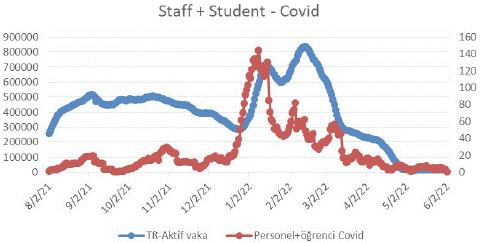
Figure 1: Comparison of all active cases with Turkey’s active cases.
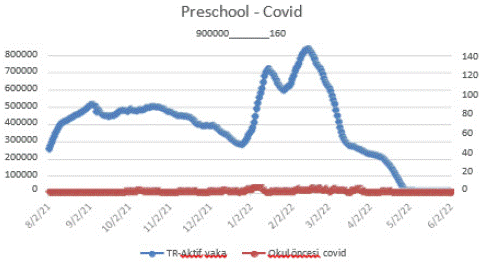
Figure 2: Comparison of number of cases in Group 1 with the number of active cases in Turkey.
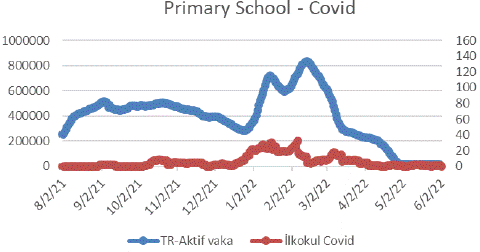
Figure 3: Comparison of number of cases in Group 2 with the number of active cases in Turkey.
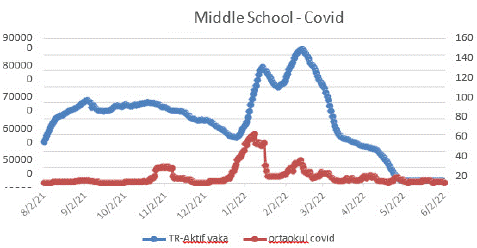
Figure 4: Comparison of number of cases in Group 3 with the number of active cases in Turkey.
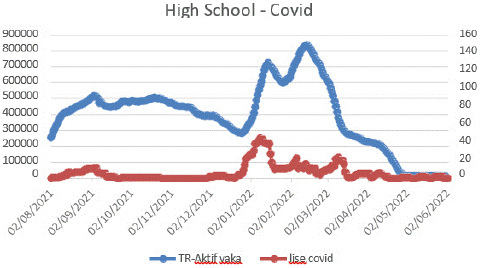
Figure 5: Comparison of number of cases in Group 4 with the number of active cases in Turkey.

Figure 6: Comparison of number of cases in Group 5 with the number of active cases in Turkey.
Covid-19 Results According to Vaccination Status
Among vaccinated students, the COVID-19 rate was 30% and the incidence density was 795/1000 school days, while among vaccinated staff, the COVID-19 rate was 42% and the incidence density was 762/1000 school days. When unvaccinated individuals were evaluated, the COVID-19 rate among students was 36% and the incidence density was 2077/1000 school days. At the beginning of the school term, all Group 5 members received at least two doses of vaccination.
When the cases diagnosed with COVID-19 were evaluated by groups, the highest number of cases among vaccinated individuals were seen in Group 5, and the highest number of cases among unvaccinated individuals was seen in Group 3 (Table 3). The time-dependent change of COVID-19 according to the vaccination status of students is shown in Figure 7. There is a remarkable difference in the number of Covid-19 positive cases among unvaccinated students and vaccinated students, although confirmed cases peaked during the same period. However, the number of Covid-19 positive cases is lower among vaccinated people (Figure 7).
GROUPS
Group 1
Group 2
Group 3
Group 4
Group 5
Vaccinated
(0.07%)Unvaccinated
(99.3%)Vaccinated
(0.09%)Unvaccinated
(99.1%)Vaccinated
(26%)Unvaccinated
(74%)Vaccinated
(73%)Unvaccinated
(27%)Vaccinated
(100%)Unvaccinated
(0%)COVID-19 Positive
0 (0)
24
(17%)2 (0.45%)
140 (32%)
33 (7.4%)
169 (38%)
109 (22%)
43 (9%)
138 (42%)
0
COVID-19 Negative
1
(0.07%)119 (83%)
2 (0.45%)
296 (67%)
82 (18.4%)
161 (36%)
251 (51%)
89 (18%)
192 (58%)
0
P
0.653
0.446
0.000001
0.625
-
TOTAL
1
143
4
436
115
330
360
132
330
0
Table 3: Comparison of groups by COVID-19 diagnosis.
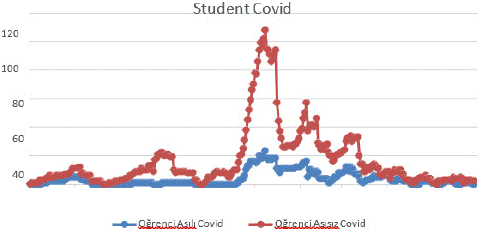
Figure 7: Time-dependent change of COVID-19 seen in vaccinated (blue) and unvaccinated (red) students.
Discussion
This study is a cohort study comparing the surveillance data obtained from a school where vaccination was carried out in accordance with universal guidelines and all necessary precautions against COVID-19 were taken with the time-dependent pandemic data across the country. One of the important points that stands out in our study is the similarity between the school's time-dependent active case curve and the country-wide case curve. However, the active peak period of the school occurred in mid-January 2022 whereas the active peak period of Turkey was in the first days of March 2022. Apart from this, the school curve declined in a shorter period of time. This may have been due to the fact that the smaller population in the school was brought under control in a shorter time with preventive measures. It may also be due to continuous and active surveillance of contacts and confirmed cases.
Active case curves for COVID-19 have been increasing during various time periods of the disease. This increase is related to the period of emergence of new variants rather than seasonal fluctuation. Di Domenico et al. showed that the increase in cases in Turkey was mostly due to COV2 variants [4]. This study also showed that in the face of increasing numbers of cases during the academic year, all conventional measures combined with patient isolations, vaccination and regular testing procedures can be managed without the need to close schools.
In our study, an increase in the number of COVID-19 cases was observed with the lifting of restrictions and the start of face-to-face education, which was not different from the general population. In a study comparing data from 8,764 face-to-face and 9,997 distance education schools in Brazil, the cumulative incidence of COVID-19 was 20 cases and 0.5 deaths per 1,000 people in open schools and 18 cases and 0.45 deaths per 1,000 people in closed schools. These findings are consistent with our study results, and keeping schools open during the pandemic did not pose a higher risk of cases than the general population [5].
Another noteworthy point is the gradual decline in the number of cases from mid-January 2022 despite the Omicron variant, which carries a high risk of transmission. This trend was observed in Turkey as of the first days of March 2022 and the decline continued in the following months. The decline in the number of cases across the country may be linked to the effectiveness of vaccination and increased herd immunity. Indeed, it is reported that the protection of m-RNA vaccines reaches 60-70% after the third dose and provides effective protection [6,7].
The highest incidence density on the school day was observed in the unvaccinated student population. Hybrid education was continued to provide uninterrupted education to these students during their 7-14 days of rest. Due to the natural disasters encountered in the USA, the necessity of uninterrupted education of students has been demonstrated [8]. One of the striking effects of COVID-19 is undoubtedly the rapid spread of distance communication and education models and their transformation into a permanent alternative worldwide. This trend has brought many opportunities in the business world as well as education.
In our study, the number of COVID-19 cases reached the highest levels during the Omicron period, which reached the level of the Delta variant in four months from March 2022 and plateaued. The decrease may be related to the high antibody level provided by repeated booster vaccinations.
In this study, Group 5 was fully vaccinated, and the highest vaccination rate among students was found in the 14-18 age group (Group 4). Group-3 had the lowest vaccination rate and the highest number of cases and incidence density (p=0.000001). This may have been due to the difficulty of controlling the 10-13 age group outside of school and their risky social interactions. As a matter of fact, it has been reported in various studies that adolescents aged 10-14 years have higher COVID-19 susceptibility than adolescents and adults [9,10].
In our study, the use of rapid diagnostic tests and active surveillance within the framework of universal preventive measures yielded effective results. In a study, the sensitivity and specificity of SARS-CoV-2 rapid antigen tests with oral, intranasal and nasopharyngeal administration were examined and it was shown that the results of rapid antigen tests performed with intranasal swab samples were highly reliable [11].
Although our study provides detailed information about the COVID-19 pandemic in an educational institution, it has some limitations. These include the inability to identify the sources of transmission of the disease, the social interaction between students is not homogeneous between groups, and the suspicious contacts of students and other personnel outside the school cannot be controlled.
Conclusion
In conclusion, this study could guide potential pandemics in the future since no similar study was conducted in Turkey and it is an appropriate summary of the experienced period.
Compared to Turkey in general, the protective feature of the vaccine was more prominent in Group 5 during the Delta variant period, and the number of cases in vaccinated individuals reached similar levels to the number of cases in unvaccinated individuals due to the fact that the virus could escape from vaccine efficacy and individuals avoided booster application during the Omicron variant period. However, our study showed that the vaccine was effective and prevented hospitalizations and deaths in vaccinated patients but was not effective in mild or asymptomatic disease.
In this study, rapid diagnostic tests were found to be as reliable as PCR tests and provided rapid results with ease of application. The implementation of universal protective measures and active surveillance were effective in the successful management of the process.
These results of an educational institution in the pandemic are instructive for other educational institutions through real-life data to be prepared for possible pandemics.
References
- COVID TS. Bilgilendirme Platformu. Erisim Tarihi. 19: 9.
- https://covid19.saglik.gov.tr/Eklenti/43095/0/covid-9rehberieriskinhastayonetimivetedavi-12042022pdf.pdf.
- https://covid19.saglik.gov.tr/Eklenti/42283/0/covid-19rehbericocukhastayonetimivetedavi06012022v1pdf.pdf.
- Di Domenico L, Pullano G, Sabbatini CE, Boëlle PY, Colizza V. Modelling safe protocols for reopening schools during the COVID-19 pandemic in France. Nat Commun. 2021; 12: 1073.
- Lichand G, Doria CA, Fernandes JPC. Association of COVID-19 Inicidence and mortality Rates with School Reopening in Brazil During the COVID-19 Pandemic. JAMA Health Forum. 2022; 3: e215032.
- Andrews N, Stowe J, Kirsebom F, Toffa S, Rickeard T, et al. Effectiveness of COVID-19 vaccines against the Omicron (B.1.1.529) variant of concern. NEJM. 2021; 12: 21267615.
- Tseng HF, Ackerson BK, Luo Y. Effectiveness of mRNA- 1273 against SARS-CoV-2 omicron and delta variants. medRxiv. Published online February. 2022; 18: 10-101.
- Jahan FA, Zviedrite N, Gao H, Ahmed F, Uzicanin A. Causes, characteristics, and patterns of prolonged unplanned school closures prior to the COVID-19 pandemic-United States, 2011-2019. PLoS One. 2022; 17: e0272088.
- Viner RM, Mytton OT, Bonell C, Melendez Torres GJ. Susceptibility to and transmission of COVID-19 amongst children and adolescents compared with adults: a systematic review and meta-analysis. JAMA Pediatr. 2020.
- Arvanitis M, Opsasnick L, O’Conor R, Curtis LM, Vuyyuru C, Benavente JY, et al. Factors Associated with COVID-19 Vaccine Trust and Hesitancy Among Adults with Chronic Conditions. 2021; 24: 101484
- WÖlfl Duchek M, Bergmann F, Jorda A, Weber M, Müller M, Seitz T, et al. Sensitivity and Specificity of SARS-CoV-2 Rapid Antigen Detection Tests Using Oral, Anterior Nasal, and Nasopharyngeal Swabs: a Diagnostic Accuracy Study. Microbiol Spectr. 2022; 10: e0202921.